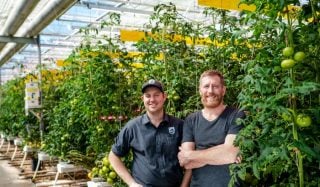Natural light often falls short on giving crops what they need to grow and flourish. With Philips professional LED grow lights you can control many aspects of crop growth to get better business results. Whether you produce vegetables, fruits or flowers – in a greenhouse, vertical farm or other indoor facility – we offer a choice of the best LED grow lights for your specific crop. Our tried and tested horticulture LED grow lights can help you increase yields, quality and consistency of your crop.

Greenhouse led grow lights
Greenhouse growers around the world use Philips indoor grow lights to improve vegetable, fruit and floriculture crops. Whether you are looking to improve propagation, growth of young plants or commercial-scale yields, Philips offers the best LED grow lights and the GrowWise Control System to improve results for any situation. Our range of horticulture LED grow lights can be used for greenhouses with standard benches, high-wire set-ups, hydroponic systems and more.

Vertical farming led grow lights
Pioneers in vertical farming are leveraging Philips innovative LED grow lights to grow a range of crops indoors in climate-controlled facilities without sunlight. These facilities are ideal for propagating young plants, cultivating leafy greens, herbs and fruits, and rapidly developing new varieties of seeds. Philips offers a range of professional LED grow lights and the GrowWise Control System to help growers achieve higher yields on a smaller footprint and steer unique properties of crops, like enhanced flavor, nutritional value and shelf life.
The latest horticulture updates

Signify and Grodan’s second collaboration
Grodan has partnered again with Signify to conduct a second research trial at Botany to optimise year-round tomato cultivation.

How different growing environments can influence nitrate levels in leafy greens
Researchers grew leafy greens under LED grow lights in a vertical farm and greenhouse and were able to decrease or increase nitrate levels in the plants.

Den Haan
Den Haan, located in Lawrencetown, Nova Scotia, chooses Philips Horticulture LED solutions for their lighting provider.
Products
Leverage proven results from Philips Light Recipes
Philips light recipes capture all the elements of lighting that steer plant growth. They are the result of hundreds of trials and projects between Philips Horticulture Lighting, growers and researchers to investigate how the LED grow light spectrum affects various crops and growing phases of plants. Today, we offer a wide array of LED grow light recipes, based on proven results for specific varieties, growth phases and cultivation set-ups.

Explore our horticultural segments

Vegetables & Fruits
High wire vegetables, leafy greens, herbs and soft fruits
Improve the quality, consistency and yield of vegetables and fruits, year-round with finely-tuned light recipes. LED grow lights supply the spectrum and intensity that crops need without adding extra heat.

Floriculture
Cut flowers, potted plants, bedding plants & perennials
The right light recipe increases flower size, propagation success and production numbers, while shortening crop cycles. LED grow lights give you full control over your plants and indoor climate in all the growth phases.

Vertical farming
Grow leafy greens, herbs and fruits without daylight
Producing profitable crops in indoor facilities. LEDs make the dream possible. They provide the optimal growth recipe to, grow healthier, pesticide-free crops, propagate young plants and maximize single or multi-layer yield indoors.
Contact us
Contact certified partners
Philips products are sold through a global network of certified partners. Find partners in your region for more information about Philips LED grow lights.
Contact Philips
What are the best LED grow lights for your situation? We are here to help. Please use our form to submit your request.
Events
Vertical Farming World Congress 2023
London, 9-11 October
IPM
Essen, 23-26 January
Fruit Logistica
Berlin, 7-9 February
Blog
Dynamic LED lighting yields significant savings
With high energy prices here to stay, we’ve seen big changes in the way growers are thinking about their use of light.

